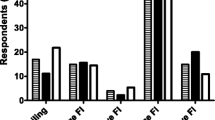Abstract
PURPOSE: The aim of this study was to determine the prevalence, severity, and associations between urinary incontinence and genital prolapse in females after surgery for fecal incontinence or rectal prolapse. METHODS: All patients who underwent surgery for fecal incontinence (Group I) or rectal prolapse (Group II) were compared with a control group of females (Group III) by 43 questions regarding demographic data, past medical and surgical history, and diagnosis and treatment of anal and urinary incontinence and genital and rectal prolapse. The type (stress, urge, and total) of urinary incontinence was determined and graded using an incontinence severity questionnaire (Individual Incontinence Impact Questionnaire). RESULTS: Overall response rate in the three groups of patients was 40.1 percent. The questionnaire was sent to 240 patients operated on for fecal incontinence or rectal prolapse, and 83 of them responded (34.5 percent). The patients were distributed into three groups: Group I consisted of 51 patients (mean age 56.7±14); Group II consisted of 32 patients (69.7±11); and Group III consisted of 40 patients (60.5±16). The prevalence of urinary incontinence in Group I was 27 (54 percent), in Group II was 21 (65.6 percent), and Group III was 12 patients (30 percent;P=0.003). Genital prolapse was present in 9 (17.6 percent), 11 (34.3 percent), and 5 patients (12.5 percent), respectively (P=0.03). The prevalence of coexistent urinary incontinence and genital prolapse in both study groups was 22.8 percent (19 patients). There were no statistically significant differences between Groups I and II relative to prevalence, type, and severity of urinary incontinence and genital prolapse, but there were significant differences between the two study groups and the control group. Of the patients in the study group, 67 percent had urinary incontinence before or at the time of surgery. CONCLUSION: There is a higher prevalence and severity of urinary incontinence and pelvic genital prolapse in females operated on for either fecal incontinence or rectal prolapse than in a control group. Therefore, female patients with fecal incontinence or rectal prolapse should be evaluated and treated by a multidisciplinary group of pelvic floor clinicians, including a gynecologist or urologist with special training in female pelvic floor dysfunction and a colorectal surgeon.
Similar content being viewed by others
References
Womack NR, Morrison JF, Williams NS. The role of pelvic floor denervation in the aetiology of idiopathic fecal incontinence. Br J Surg 1984;73:404–7.
Kok AM, Voorhorst FJ, Burger CW, Van Houten P, Kenemans P, Janssens J. Urinary and fecal incontinence in community-residing elderly women. Age Ageing 1992;21:211–5.
Jackson SL, Weber AM, Hull TL, Mitchinson AR, Walters MD. Fecal incontinence in women with urinary incontinence and pelvic organ prolapse. Obstet Gynecol 1997;89:423–7.
Bump RC, Norton PA. Epidemiology and natural history of pelvic floor dysfunction. Obstet Gynecol Clin North Am 1998;25:723–44.
Jolleys JV. Reported prevalence of urinary incontinence in women in a general practice. BMJ 1988;296:1300–2.
Olsen AL, Smith VJ, Bergstrom JO, Colling DC, Clark AL. Epidemiology of surgically managed pelvic organ prolapse and urinary incontinence. Obstet Gynecol 1997;89:501–6.
Caputo RM, Benson JT. Idiopathic fecal incontinence. Curr Opin Obstet Gynecol 1992;4:565–70.
Rekers H, Drogendijk AC, Valkenburg H, Riphagen F. Urinary incontinence in women from 35 to 79 years of age: prevalence and consequences. Eur J Obstet Gynecol 1992;43:229–34.
Davila GW, Primozich J. Quality of life assessment in urinary incontinence: evaluation of a disease specific, patient specific, short-form questionnaire. Drug Info J 1997;31:1416.
Burgio KL, Matthews KA, Engel BT. Prevalence, incidence and correlates of urinary incontinence in healthy, middle-aged women. J Urol 1991;146:1255–9.
Gill EJ, Hurt WG. Pathophysiology of pelvic organ prolapse. Obstet Gynecol Clin North Am 1998;25:757–69.
Henry MM, Parks AG, Swash M. The pelvic floor musculature in the descending perineum syndrome. Br J Surg 1982;69:470–2.
Vervest HA, Barents JW, Haspels AA, Debruyne FM. Radical hysterectomy and the function of the lower urinary tract. Urodynamic quantification of changes in storage and evacuation function. Acta Obstet Gynecol Scand 1989;68:331–40.
Sultan AH, Kamm MA, Bartram CI, Hudson CN, Thomas JM. Anal sphincter trauma during instrumental delivery. Int J Gynaecol Obstet 1993;43:263–70.
Bump RC, Mattiasson A, Bo K,et al. The standardization of terminology of female pelvic organ prolapse and pelvic floor dysfunction. Am J Obstet Gynecol 1996;175:10–7.
Theofrastous JP, Swift SE. The clinical evaluation of pelvic floor dysfunction. Obstet Gynecol Clin North Am 1998;25:783–804.
Author information
Authors and Affiliations
Additional information
Dr. González-Argenté was supported by grant B.A.E. (99/5022) from the Ministry of Sanity, Spain. This study was supported in part by a generous educational grant from ANA-Tech, LLC.
About this article
Cite this article
González-Argenté, F.X., Jain, A., Nogueras, J.J. et al. Prevalence and severity of urinary incontinence and pelvic genital prolapse in females with anal incontinence or rectal prolapse. Dis Colon Rectum 44, 920–925 (2001). https://doi.org/10.1007/BF02235476
Issue Date:
DOI: https://doi.org/10.1007/BF02235476




